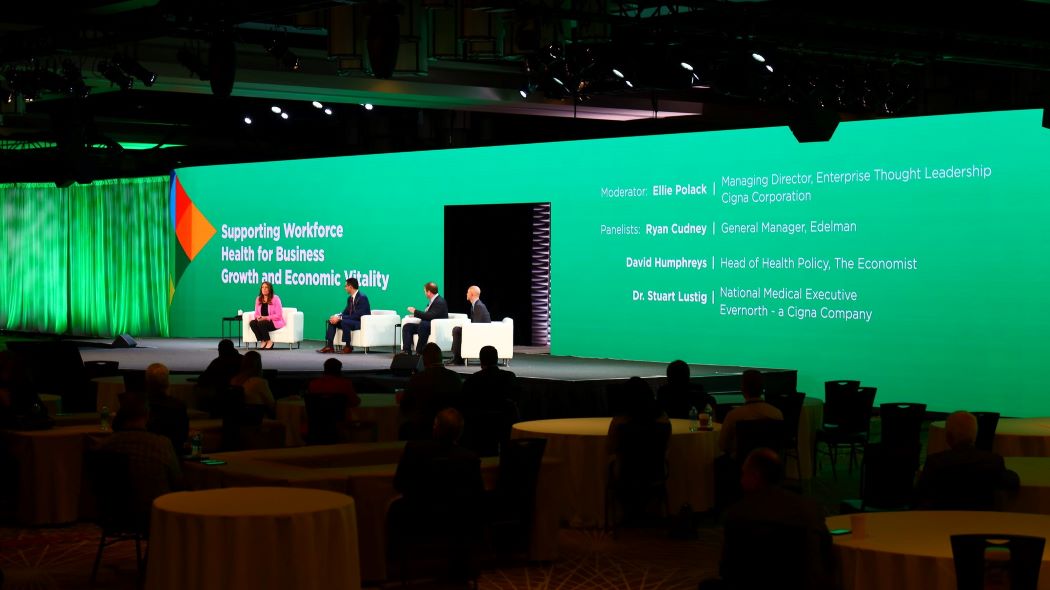The COVID-19 pandemic has brought to light the inextricable link between employee health and well-being, and business and economic success, as evidenced in a recent study by Economist Impact, commissioned by Cigna.

The COVID-19 pandemic has brought to light the inextricable link between employee health and well-being, and business and economic success, as evidenced in a recent study by Economist Impact, commissioned by Cigna. The numbers back it up. Employer-driven health interventions can result in a 76% ROI due to productivity increases. Employees receiving health and well-being benefits at work are less likely to be absent, which results in 70% fewer work days missed over a year. And, companies that rank in the top quartile of employee engagement are 23% more profitable.
The good news: Businesses are in a unique position to promote workforce health, as today’s workers consider their employer to be the most trusted sources of information, according to research from global communications firm Edelman. Edelman’s most recent Trust Barometer finds that people trust their employers more than mainstream media and the government.
Edelman’s research also found that people are looking to employers to help address problems in the community. In fact, by a five-to-one margin, people want more business engagement on societal issues, including health care access, so it is imperative for businesses to take the lead. Though it is important to note that while people would like business leaders to engage in shaping the policy to address these issues, they do not want businesses involved in the politics behind it.
These were just some of the key insights shared in a panel discussion titled, "Supporting Workforce Health for Business Growth and Economic Vitality," held at the Cigna 2022 Client Forum in San Antonio, Texas. During the panel, David Humphreys, head of health policy and clinical evidence for Economist Impact Healthcare Practice, Ryan Cudney, general manager of Edelman, and Dr. Stuart Lustig, national medical executive for behavioral health at Evernorth, Cigna Corporation's health services business, discussed the critical role employers play in enabling their workers to live healthier and more productive lives. They also provided some best practices for organizations to consider in regards to using their trusted influence to advance a business culture of health.
Best Practice #1: Strengthen Leader-Worker Connections with Quality Communication and Employee Involvement
The panel agreed that the promotion of a healthy workforce needs to start at the top of the organization. “A CEO is expected to be personally visible championing a culture of health,” said Cudney, adding that the Edelman Trust Barometer research indicates that quality information is key, as employer communications are the most trusted channel for receiving information.
Humphreys said that leaders need to be sincere in their communications and need to understand the employee’s point of view.
“Employees and their definition of well-being are actually far ahead of the average employer."David Humphreys, head of health policy and clinical evidence, Economist Impact Healthcare Practice
The Economist Impact study supports this notion of a disconnect between workers and senior leaders on how they define a healthy workforceexecutives. For example, executives ranked “having access to quality health care” as the most important aspect of employee health, whereas workers ranked “having a good work-life balance” as most important. Humphreys suggested executive leaders and senior managers gather employee input to inform health improvement initiatives to address the issues that matter to their workforce. “Try to understand what the employee well-being needs are, and make sure those needs are transmitted back into the communications and the [workforce health] policies,” he concluded.
Best Practice #2: Promote and Destigmatize Mental Health
In terms of promoting and destigmatizing mental health, it’s important that employers address fatigue, stress and burnout, which employees and executives surveyed say are the top barriers to business growth. The Economist’s Humphreys expects employee mental health to continue to be a pervasive workplace issue that can negatively impact employee morale and job satisfaction, which can lead to lower productivity and higher turnover. Humphreys stated that mental health issues were a main reason one third of workers changed their jobs in 2021.
70% of employees surveyed see the workplace to be a primary driver of stress.
But there is some good news: The Economist Impact survey finds a greater level of acceptance of mental health programs today.
“What has happened in 2020 to 2022 has made it now okay to not be okay,” Evernorth’s Dr. Lustig said, adding that the pandemic was the first time the public collectively acknowledged that people should seek help for stress and mental health issues. He also said the rapid expansion of practitioners adopting virtual appointments in recent years enabled more people to conveniently connect to the care that they needed.
While more employees and employers see the importance of mental health care, organizations still need to do more to destigmatize mental health issues. Humphreys pointed out a quote from a focus group participant who expressed concerns about possible job repercussions for addressing their mental health:
“I have liked that they have things [to support me], but I do feel like there may be some challenges because I don’t know how comfortable I feel taking mental wellness or sick days. In the back of my head I am wondering if they had to cut people, are they going to have access to that information. I would think that affects the decision.”
— Employee focus group participant, Economist Impact Healthy Workforce Study
Humphreys stressed that employees need to have a level of trust with their employers to take advantage of the mental health and wellness resources those organizations provide. Establishing that trust is, again, where senior leadership plays a critical role.
Dr. Lustig recommends business leaders build a work culture that encourages employees to seek the help when needed. In this culture, senior executives and team leaders would recognize the importance of mental health care or taking time off to de-stress, and would set an example to employees by demonstrating how they address their own mental health needs. “That makes it more okay for people to access the treatment that they need, even during the course of the workday” Lustig said. He also noted the importance of leaders and team members having one-to-one candid conversations regarding when they would not be available to work so they can attend a doctor appointment or take care of a loved one. “Building these types of expectations into discussions between managers and direct reports at all levels can make a big difference,” Lustig said.
Best Practice #3: Build Workforce Resilience by Promoting Work-Life Balance and an Inclusive Workforce Culture
Companies that promote work-life balance and an inclusive work culture will ultimately build greater resilience, Dr. Lustig said. A 2020 Cigna nationwide study found that only two out of five people surveyed had optimal resilience to face life’s challenges.
Lustig mentioned that having optimal physical and mental health is key to being resilient, and one actionable way organizations can enable this is to encourage work-life balance for their employees. However, employers need to be flexible with enabling work-life balance as it can mean different things to different people.
“For some employees, it means they are on the clock at this hour, and off the clock at that hour. So there would be blackout periods where they should not be expected to answer e-mails or their phone,” Lustig said. “For others, it’s going to have the flexibility in their schedule to do work at different times so they would be available to take care of a loved one when needed.” Lustig recommended business leaders to engage with their employees to find out what “work-life balance” means for them, and consider variable policies to better support individual employee needs.
Lustig also mentioned that their research indicated that lower resilience levels correlated with a greater intention for workers to quit their jobs, and suggested that businesses foster a sense of belonging and purpose among their employees. This can be done in part by having CEOs leverage their communications to help employees understand why they are coming to work every day.
"When people feel they are connected to something bigger than themselves, and to the mission of the organization, they are more likely to be resilient and stay at work as well."Dr. Stuart Lustig, national medical executive for behavioral health, Evernorth
He also stated that employees who work in an inclusive and diverse environment, as well as feel that they can be their “true, authentic selves” at work, had reported higher resilience levels than employees who don’t.
Best Practice #4: Demonstrate Commitment and Accountability
Humphreys underscored the importance of CEOs and senior executives to not just demonstrate leadership in promoting workforce health, but accountability as well. Companies recognize the importance of a healthy workforce, so they should set key performance indicators (KPIs) around healthy workforce goals, Humphreys said.
Currently, senior executives ranked “employee health and well-being” sixth on a list of indicators used to measure business performance, according to Economist Impact survey data. Humphreys concluded that workforce health should be considered a top priority, to which organizations should demonstrate a multi-year commitment from the CEO-level down.
“A company’s rhetoric has to meet reality.”Ryan Cudney, general manager, Edelman
Cudney also noted that Edelman’s research shows that two-thirds of employees are more willing to work for a company that follows through on its commitments.
Strengthening the Foundation for Business Success
The panel discussion emphasized the fundamental need for businesses to establish and foster an organizational culture of workforce health. Executive leaders are an essential force to build this culture, and should take advantage of their position of trust to inspire healthier practices and engage employees to improve their personal well-being.
Companies that actively involve their employees in the development of health policies, as well as promote acceptance of mental health support, greater work-life balance and workforce inclusion, while holding themselves accountable by setting priority KPIs around a culture of health, will be better able to advance worker well-being, higher productivity and better business performance.

Employee Well-being is Your New Growth Plan
Browse through our thought leadership content and resources on what it is going to take to attract and retain top talent in the future of work.


